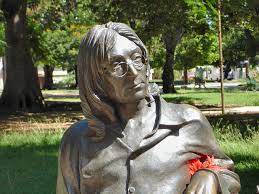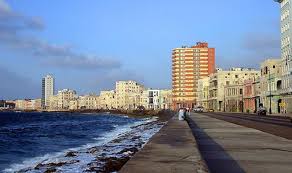
LA ESCULTURA DE BRONCE DE JOHN LENNON EN LA HABANA, CUBA CON SUS ACTUALES GAFAS DESMONTABLES. FOTOS.
El Parque John Lennon o Parque John Lennon (antes conocido como Parque Menocal) es un parque público, ubicado en el barrio del Vedado en La Habana, Cuba.
En uno de los bancos del parque, más cerca de la esquina de las calles 17 y 6, se encuentra una escultura del ex Beatle John Lennon, esculpida por el artista cubano José Villa Soberón, sentado en el extremo derecho del banco.
El lugar tiene forma rectangular, con una plaza circular en el centro rodeada por un muro que se divide en cuatro extremos, permitiendo el acceso a través de escaleras de 9 escalones. Cuenta con grandes arboledas, plantas ornamentales y césped. Un hermoso parque con amplios pasillos y bancos de hierro, donde la frescura y el verdor lo convierten en un lugar muy agradable.
En 1964, el régimen de Castro prohibió a los Beatles en Cuba, poco después de su aparición en American TV program The Ed Sullivan Show. La prohibición se emitió porque los Beatles eran vistos como un producto del sistema capitalista y su música se consideraba una amenaza para la revolución. Escuchar a los Beatles era casi una traición y podía llevar a un arresto.
Sin embargo, la actitud de Castro hacia los Beatles cambió a finales de los años 90, cuando Cuba necesitaba ingresos provenientes de los turistas occidentales.
LOS RECUERDOS NACEN CON UN PROYECTO
A principios de los años noventa, el primer concierto en honor a Lennon comenzó a gestarse y fue una iniciativa de Carlos Alfonso, Ele y Síntesis, a la que se sumaron también los músicos Carlos Varela, Santiago Feliù, Pepe Piñeiro (exmiembro de Los Pacíficos), Dagoberto Pedraja, el grupo Gens, Pablo Menéndez y su grupo Mix, Gerardo Alfonso, otros músicos y, por supuesto, un grupo de amigos cineastas, escritores, pintores, técnicos y locos por la vida que tuvieron el sueño de homenajear a Lennon y a Los Beatles.
Hacer justicia por la ofensa e ingratitud que había significado la prohibición oficial de los Cuatro de Liverpool en Cuba en los años 60 y 70. El concierto se realizaría en la azotea del Hotel Habana Libre, en la esquina de L y 23, pleno corazón de La Rampa y una de las zonas más concurridas de la capital.
El plan era montar todo el equipo de grabación de sonido y vídeo un viernes y que coincidiera con las actividades del Festival Internacional del Nuevo Cine Latinoamericano, pero sin hacer la más mínima publicidad o anuncio, de forma similar a como John, Paul, George y Ringo lo habían hecho en Inglaterra en el último concierto de fin de sus años como banda y que popularmente se denominó “concierto en la terraza” o “concierto en la azotea de los estudios Apple”.
Sin embargo, esto no fue aprobado por las autoridades gubernamentales, pero entonces surgió la posibilidad de hacerlo en el parque de la 17. Los vecinos de esa zona habían dado su apoyo y se han mantenido para colaborar con el evento.
LA ESCULTURA VISIBLE
La escultura de Lennon actualmente no lleva sus características gafas de lentes redondas, que han sido robadas, o vandalizadas, varias veces. Sin embargo, durante el día, un guardia de seguridad se sienta junto al banco y coloca los lentes sobre la estatua si se lo piden.
La estatua fue inaugurada el 8 de diciembre de 2000, el 20 aniversario del asesinato de Lennon. Un año después, el autor cubano Ernesto Juan Castellanos escribió un libro sobre la estatua, John Lennon en La Habana con un poco de ayuda de mis amigos, y sobre la prohibición que John Lennon y los Beatles sufrieron en Cuba durante los años 1960 y 1970.
Hoy en día, hay varios lugares en Cuba que rinden homenaje a los Beatles, entre ellos:
Submarino Amarillo: Un bar con decoración temática de los Beatles y paredes cubiertas de imágenes de la banda y sus canciones
Bandas cubanas: Tocan versiones de éxitos de los Beatles y otras canciones de rock.
The estatua de John Lennon: Ubicada en el pequeño parque en La Habana
La placa con la inscripción “Puedes decir que soy un soñador, pero no soy el único” estará en el recuerdo y el corazón de los muchos que mantienen a John Lennon y los Beatles en su memoria.


JOHN LENNON BRONZE SCULPTURE IN LA HAVANA, CUBA WITH HIS CURRENT REMOVABLE GLASSES. PHOTOS.
John Lennon Park or Parque John Lennon (formerly known as Parque Menocal) is a public park, located in the Vedado district in Havana, Cuba.
On one of the benches of the park, nearer the corner of streets 17th and 6th, there is a sculpture of the former Beatles member John Lennon, sculpted by Cuban artist José Villa Soberón, seated on the bench’s right end.
The place has a rectangular shape, with a circular plaza in the center surrounded by a wall that is divided into four ends, allowing access through 9-step stairs. It has large groves of trees, ornamental plants and grass. A beautiful park with large corridors and iron benches, where the freshness and greenery make it a very pleasant place.
On 1964 the Castro Regime banned the Beatles in Cuba, shortly after their appearance on The Ed Sullivan Show. The ban was issued because the Beatles were seen as a product of the capitalist system, and their music was considered a threat to the revolution. Listening to the Beatles was almost treasonous, and could lead to arrest.
MEMORIES BORN A MEMORY PROYECT
At the beginning of the nineties, the first concert for Lennon began to take shape and was an initiative of Carlos Alfonso, Ele and Síntesis, which was also joined by the musicians Carlos Varela, Santiago Feliù, Pepe Piñeiro (former member of Los Pacíficos), Dagoberto Pedraja, the group Gens, Pablo Menéndez and his group Mix, Gerardo Alfonso, other musicians and, of course, a group of friends who were filmmakers, writers, painters, technicians and crazy people about life who had the dream to honor Lennon and The Beatles.
Do justice for the offense and ingratitude that the official ban of the Liverpool Four in Cuba had meant in the 60s and 70s. The concert would take place on the low roof of the Habana Libre Hotel, on the corner of L and 23, the heart of La Rampa and one of the busiest areas of the capital.
The plan was to set up all the sound and video recording equipment on a Friday and to coincide with the activities of the International Festival of New Latin American Cinema, but without making the slightest publicity or announcement, in a similar way as John, Paul, George and Ringo had done it in England in the last concert at the end of their years as a band and which was popularly called “concert on the terrace” or “concert on the roof of Apple Studios.”
However, this was not approved by the government authorities, but then the possibility of doing it in the park on 17 arose. The residents of that area had given their support and has remain to collaborate with the event.
THE VISIBLE SCULPTURE
The Lennon sculpture is currently not wearing its trademark round-lensed glasses, which have been stolen, or vandalized, several times. However, during the day, a security guard sits next to the bench and places the glasses on the statue if asked.
The statue was inaugurated on December 8, 2000, the 20th anniversary of Lennon’s murder. A year later, Cuban author Ernesto Juan Castellanos wrote a book about the statue, John Lennon in Havana with a Little Help from My Friends, and about the ban that John Lennon and the Beatles suffered in Cuba during the 1960s and 1970s.
Today, there are several places in Cuba that pay tribute to the Beatles, including:
Yellow Submarine: A bar with Beatles-themed decor and walls covered with images of the band and their songs
Cuban bands: They play covers of Beatles hits and other rock songs.
The statue of John Lennon: Located in the small park in Havana
The plaque with the inscription “You may say I’m a dreamer, but I’m not the only one” will be in the memory and hearts of the many who keep John Lennon and the Beatles in their memory.

Agencies/ Wiki/ JohnLennonPark/ Extractos/ Excerpts/ Internet Photos/ Arnoldo Varona/ www.TheCubanHistory.com
THE CUBAN HISTORY, HOLLYWOOD.




